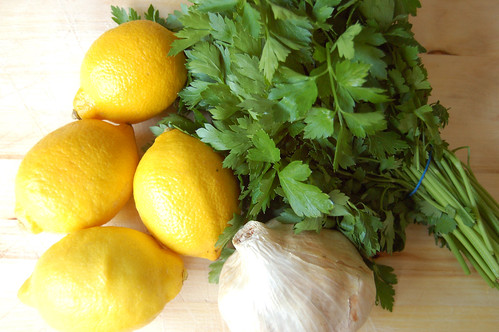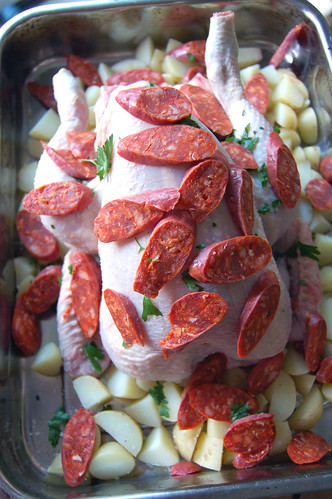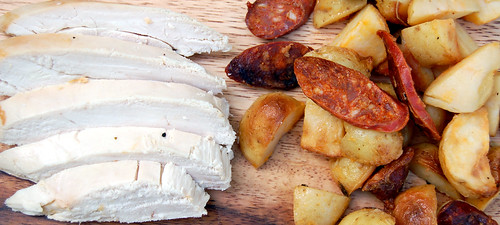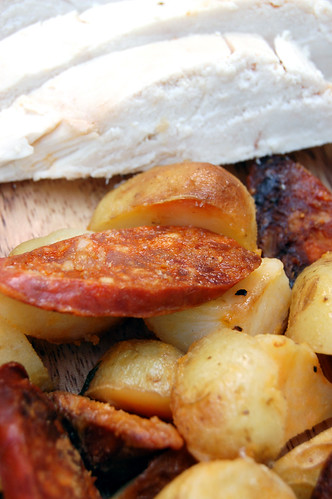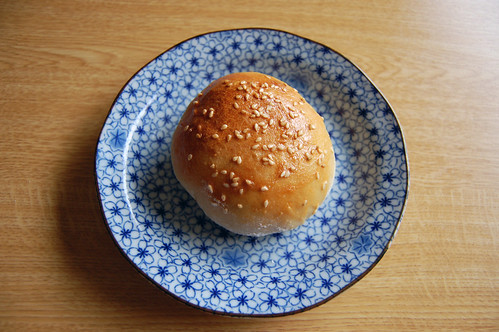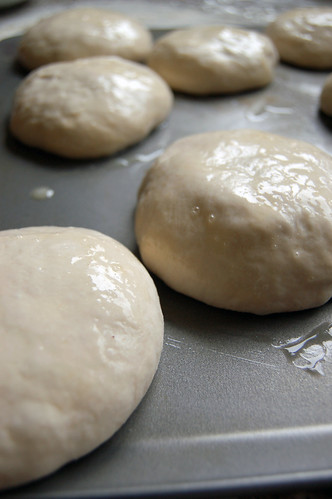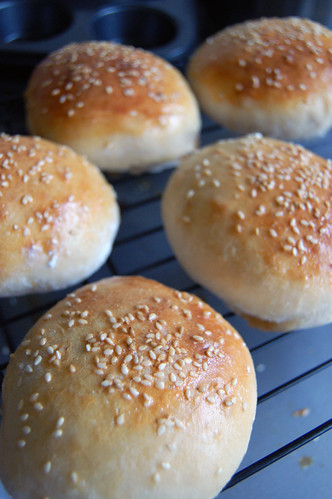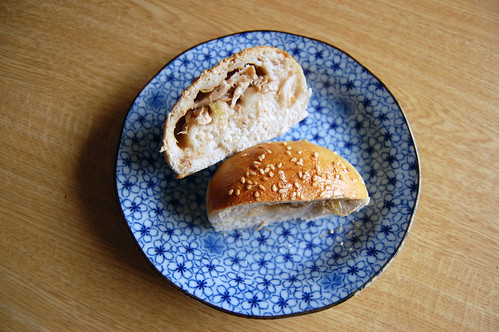Tuesday, 8 September 2009
Skippity Skip
I've moved home and am now at http://distractedgourmet.wordpress.com/. Please direct your browser there.... NOW!
Friday, 4 September 2009
52 weeks, 52 chickens: Week Two - Super Tasty Spanish Roast Chicken
So, week two got off to a good start, after I went to the Hampshire Farmer's Market to pick up a lovely free range chook from Noah's Ark Farm. I was making another Jamie Oliver recipe, also from Jamie's Dinners, called Super Tasty Spanish Roast Chicken - how could I resist, really? There's no 'cooked' photo in the book, and I haven't got one either, as I ran out of light, but the thought of crispy roast chicken skin tinged with the dark crimson of smoked paprika from the chorizo garnish was enough to get me motivated. I had to cheat here slightly as Jamie's very keen that I buy an organic free range bird, but the only ones I found at the market were about double the price of a supermarket one. Why should I pay for a chicken to eat what I can't afford? Pah!
So, here's the bird - £8.41, not too bad. And with giblets... scary! Luckily, these were bagged and were swiftly removed to the freezer. I haven't come across a recipe that needs them yet, but I'm sure I will, and it always seems to be when you don't actually have any... I've had a traumatic past experience with giblets which gives me a totally legitimate reason to get freaked out by them, I'll have you know. As a spotty youth I was charged with making the roast dinner at my uncle's house one Sunday, and, for some reason, this involved me submerging a whole chicken in a sink of water, probably to defrost it. As I did so, the cavity filled with water, and out popped a dishevelled brown bag filled with chicken guts, which promptly exploded and covered my hands and the dead chicken with scraps of heart and liver. Ugh. I tend to keep away from guts now...
Anyway, so. Here's the costing:
Noah's Ark free range chicken, 2.2kg : £8.41
Tesco chorizo sausage : £2.99
2 for 1 baby potatoes, costed for one 1kg packet : 59p
4 lemons : £1.00
Bunch parsley : 79p
Garlic : 20p
Grand total : £13.71
Chorizo is so damn expensive, but luckily, it's totally worth it.
So, Jamie wants you to make a (looks it up) gremolata, which is chopped lemon zest, raw garlic and parsley. Never made this before, and it was delicious. I don't know that it will be my condiment of choice for roast chicken hereafter, but a little exploration is what it's all about, right?
Note that Jamie's recipe calls for a beaten egg - this phantom egg doesn't appear in his online version, but it's been confuddling cooks online for a while, because it never gets used in the recipe. I think maybe Jamie just wants you to beat an egg for this recipe so that you can ponder that age old question - which came first? His answer being, presumably, that the egg never came at all. Wow, philosophical...
So, here is the chicken all dressed up and ready to party. The cavity is filled with hot lemons and parsley stalks - I definitely will always boil my lemons first before adding them to a chicken to roast. I first came across this in another Jamie recipe and it really helps the lemon scent to flavour the bird - it steams it in lemon scent. Of course, I am an idiot, and I turned the oven off about ten minutes before this step, so the chicken had to sit on the side and generate some delightful bacteria before I could put it in the oven. No, luckily that didn't happen, but obviously hot food + raw poultry + sitting around = bad idea.
Before you pop the chook in the oven, though, you have to cover it in damp parchment paper, which 'seal in the juices'. I have to say, this part didn't work so well for me. The paper got quite burned, and left a bitter taste to the flesh and juices, and charred paper also coloured the stock a muddy grey. I don't know how necessary it is, but I might use foil if I did it again... Which I won't for a WHOLE YEAR. Probably.
This is the stunt double meal - like I said, by the time I got to serving dinner, the light had totally gone, but luckily there was enough left over for me to take this shot the next day.
I served the chicken with ratatouille and Leon's Magic Beans, and it was delicious.
Scores:
M gave it 8.5. He likes chorizo, he likes chicken, he likes potatoes. Altogether, a pretty good combo. The gremolata went down well, so a good success. But he did wonder how it was possible to ever score a 10, and frankly, so do I...
I gave it 8. I really liked it, but it somehow wasn't chorizoy enough for me. I wanted the rich, greasy, spicy taste of the chorizo, cut with the zesty fire of the fresh lemon. It was a lot more subtle than that. Also, the parchment paper really didn't do well on top, and I didn't like having grey gravy... And, as per Jamie's instructions, I sprinkled parsley on the top, which was a mistake, as it pretty much got cremated and turned very bitter. On the up side, it made delicious spuds and we had loads for lunch the next day!
Sunday, 30 August 2009
Julia Child and Yan Can Cook
When I was a kid, me and my mum would watch the food channel on cable TV endlessly. I really miss those programmes. Nowadays we have loads of UK-centric programmes and British food celebrities like Nigella Lawson and Jamie Oliver. But when I was little and I wanted to watch a TV programme, who I really wanted to watch was Julia Child and Martin Yan.
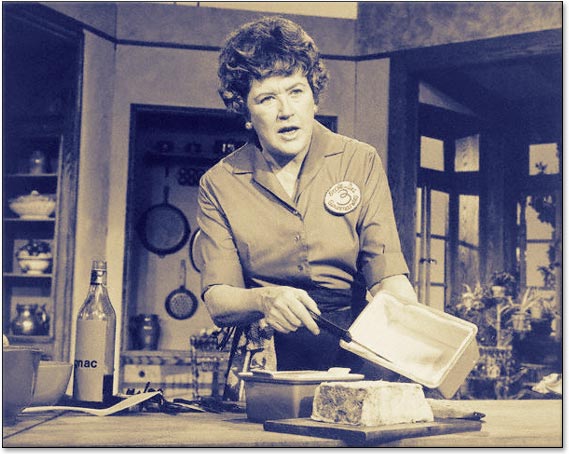 Julia Child isn't particularly well known in the UK, but she's hugely loved in America. What I loved about her, apart from her crazy voice, was her slapdash attitude which saw food flicking all over the place. Yet somehow, out of what I perceived to be culinary chaos, she managed to turn out pretty damn good dishes. To be honest, I loved Julia Child more for the comedy value, but the more I've learned about her since I've also come to respect her as an accomplished chef. I'd love to read her book Mastering the Art of French Cooking, especially after starting to read The Julie/Julia Project. It seems as though the foodie world is aflame with plenty of Julia love, thanks to the recent movie based on the blog, starring Meryl Streep. The film hasn't come out in the UK yet, but I don't think it'll make great waves here - as I've said, Julia Child isn't really a big name for the British public. Our equilvalent is, of course, the reliable and slightly fiesty Delia Smith.
Julia Child isn't particularly well known in the UK, but she's hugely loved in America. What I loved about her, apart from her crazy voice, was her slapdash attitude which saw food flicking all over the place. Yet somehow, out of what I perceived to be culinary chaos, she managed to turn out pretty damn good dishes. To be honest, I loved Julia Child more for the comedy value, but the more I've learned about her since I've also come to respect her as an accomplished chef. I'd love to read her book Mastering the Art of French Cooking, especially after starting to read The Julie/Julia Project. It seems as though the foodie world is aflame with plenty of Julia love, thanks to the recent movie based on the blog, starring Meryl Streep. The film hasn't come out in the UK yet, but I don't think it'll make great waves here - as I've said, Julia Child isn't really a big name for the British public. Our equilvalent is, of course, the reliable and slightly fiesty Delia Smith.Now, Martin Yan. All I really remember is him shouting 'if Yan can cook, so can you!', then furiously chopping some vegetable into ridiculously thin slices, or pulling off some amazing feat of culinary skill totally beyond the realm of normal people. I can safely say, Martin Yan has more skill in the kitchen than I ever will, but his infectious, goofy presenting style also won my girlish heart. Bless him! Completely coincidentally, he's also the author of Chinese Cooking for Dummies, which sits proudly on my bookshelf near Sushi for Dummies, Puppies for Dummies and Cats for Dummies. All fantastic recipe books.
"Set it aside!"
Saturday, 29 August 2009
52 Weeks, 52 Chickens: Week One - Leftovers, hoisin chicken buns
I thought I'd see whether I could adapt a recipe I'd used and loved before - hoisin chicken buns from Cooking Light, by way of Cooking Cute. I tried it, and it worked well, although I'm always a bit funny about using leftover chicken and not cooking the hell out of it. I'm still alive, though... so I guess in that respect it was a complete and utter success. Maybe if I made this again, I'd heat the chicken before stuffing it in the bun, but it does get cooked again in the oven, so maybe that would be overkill.
To make this recipe, I made a batch of white bread dough, which is never any sweat with my bread maker. The original recipe calls for frozen dough, but I've never seen that before here in the UK - and it's just yeast, water, salt and flour after all, so easy to put together.
The filling I stripped from the chicken carcass - I must have used the meat from one leg and two thighs, plus whatever I pulled from underneath. Shred it up, then add it to 3 tbsp hoisin sauce, 1 tbsp oyster sauce, 2 tsp rice vinegar and a bunch of spring onions you've shredded finely. I also added salt to mine, but my hoisin sauce was that terrible cook-in sauce stuff, rather than the proper condiment you eat with duck. If you manage to pick up some real hoisin sauce (why was that so hard, Sainsbury's?) then you should reduce the amount you use down to 2 tbsp.
Once you've made your dough, turn it out and cut it into eight pieces (or more if you're making them for bento), and roll each piece into a size slightly bigger than your palm. Place a spoonful of the chicken mix into the middle. Pull four corners into the middle and pinch, then do the same again with the leftover tabs. It's helpful to rock the bun back and forth at this point to shape the top nicely. Set it on an oiled tray and put the rest together.
Cover and allow to prove for 20 mins in a warm place. Preheat your oven to 190C and then brush the buns with beaten egg and sprinkle with sesame seeds. Bake for 15 mins, or until golden. You can also bake them for a shorter amount of time (12 mins or so) and then freeze them to bake again another day. (There are great instructions here for freezing and then reheating the buns at Cooking Cute.)
Allow to cool slighty, then eat!
These also make a great lunch or snack, and can be eaten hot or cold. I really love these chicken buns! But, please make sure that everyone has one before you start to eat... unfortunately, the spring onions are a little whiffy. M ate one in the cinema the other day when we went to see Inglourious Basterds, and it didn't really help the atmosphere, I have to tell you.
In other news, I'm off to the farmer's market tomorrow to pick up my second chicken. Whoo! Wish me luck - I'm leaving really early so hopefully I can bag a good chook!
To make this recipe, I made a batch of white bread dough, which is never any sweat with my bread maker. The original recipe calls for frozen dough, but I've never seen that before here in the UK - and it's just yeast, water, salt and flour after all, so easy to put together.
The filling I stripped from the chicken carcass - I must have used the meat from one leg and two thighs, plus whatever I pulled from underneath. Shred it up, then add it to 3 tbsp hoisin sauce, 1 tbsp oyster sauce, 2 tsp rice vinegar and a bunch of spring onions you've shredded finely. I also added salt to mine, but my hoisin sauce was that terrible cook-in sauce stuff, rather than the proper condiment you eat with duck. If you manage to pick up some real hoisin sauce (why was that so hard, Sainsbury's?) then you should reduce the amount you use down to 2 tbsp.
Once you've made your dough, turn it out and cut it into eight pieces (or more if you're making them for bento), and roll each piece into a size slightly bigger than your palm. Place a spoonful of the chicken mix into the middle. Pull four corners into the middle and pinch, then do the same again with the leftover tabs. It's helpful to rock the bun back and forth at this point to shape the top nicely. Set it on an oiled tray and put the rest together.
Cover and allow to prove for 20 mins in a warm place. Preheat your oven to 190C and then brush the buns with beaten egg and sprinkle with sesame seeds. Bake for 15 mins, or until golden. You can also bake them for a shorter amount of time (12 mins or so) and then freeze them to bake again another day. (There are great instructions here for freezing and then reheating the buns at Cooking Cute.)
Allow to cool slighty, then eat!
These also make a great lunch or snack, and can be eaten hot or cold. I really love these chicken buns! But, please make sure that everyone has one before you start to eat... unfortunately, the spring onions are a little whiffy. M ate one in the cinema the other day when we went to see Inglourious Basterds, and it didn't really help the atmosphere, I have to tell you.
In other news, I'm off to the farmer's market tomorrow to pick up my second chicken. Whoo! Wish me luck - I'm leaving really early so hopefully I can bag a good chook!
Labels:
52 weeks 52 chickens,
Hoisin chicken bun,
leftovers,
recipe
Friday, 28 August 2009
Dishing the dirt on Thanksgiving 2008
I've already mentioned that I love Thanksgiving. It allows me to, without constraints of expectation, indulge in a huge amount of culinary exploration, cook scores of brand new dishes, obsess for days and days over what I'm going to cook, and buy loads of new cookbooks. Oh, and look at photos of Thanksgiving tables on Flickr for hours to figure out what everything's supposed to look like. None of my friends or family really know what it's all supposed to taste like, so whether it's a disaster or a triumph, it's going to get eaten just the same.
However, I do tend to get carried away.
This is blindingly obvious to you, I'm sure, having read the first paragraph. Gemma's rule of cooking number one, is why cook one dish, when you can cook three? Last year, that was translated into Thanksgiving terms as, why only have roast potatoes, when you can have three kinds? Also, why have two side dishes, when you can have seven? And, why not do it all, barring the intervention of my sainted mother, pretty much by yourself?
My long suffering mother helped here with the cooking, and she laid the table and provided the house and kitchen that hosted these festivities, but when it comes to the kitchen, I'm a bit of a lone ranger. There's no way I expect other people to have the same kind of dogged determination as I do when it comes to these epic feasts. Besides, life's no fun unless you're pitting your very being against the clock. If I ever thought anything to do with cooking was easy, my first instinct has always been to make it harder. More of everything! Double the quantities! Can we fit in another course?
So, mostly for the purposes of self-gratification, here's my menu from Thanksgiving, 2008.
So, let's break it down.
My soup starter came from Thanksgiving 101, by Rick Rodgers, page 21. It's basically a creamy butternut squash soup with salty, savoury ribbons of pink Italian air-dried ham stirred in, and was really nice. I'd make it again for Thanksgiving, but like a lot of the things I eat for this stolen American holiday, I wouldn't eat it any other time. The pate is a bit of a cop-out, shop-bought and served with toast, a bit of a concession to the fussy eaters in the family. As you can see from the rest of the menu, there's a lot of that going on!
Savoury Apple-Onion Turkey, and the accompanying gravy, came from Betty Crocker's Complete Thanksgiving Cookbook, page 20-1. I don't remember this being amazing, but I think the gravy was a bit of a disaster. I've never made a gravy I've liked that wasn't our family recipe. This is not the fault of other gravy, or particularly an indication of the greatness of our gravy. I just can't get along with other gravies, or I completely have no clue how to make gravy 'properly'. I'd love to make a gravy I liked, but if I want something to satisfy my gravy urge, I have to break out the roast juices, Bisto powder and Oxo cubes. For shame! Other people liked the apple cider gravy, but I could happily never have it again.
The roasties are self-explainatory, but the classic mashed potatoes are another Betty Crocker recipe, same book, page 71. However, since then, I have discovered the ultimate mashed potato recipe in Sheila Lukins' bloody fantastic USA Cookbook. It's called Garlicky Red-Jacket Mashed Potatoes, and it is the only mashed potato recipe I'll ever bother with. It involves cider vinegar (ha ha, a use for that new bottle of Norman cider vinegar I brought back from my holiday), sour cream and red potatoes, and it's glorious. Bless Sheila Lukins and her kick-ass cookery book. I'm slowly reading every single recipe in there like it's my new religion, and I can also whole-heartedly recommend her awesome Tomato Balsamic Vinaigrette, which is so good I don't mind how fiddly it is. Anyway. The sweet potatoes were actually slow cooked, another good old BC recipe (page 79 - I hope someone's using these... who am I kidding?). I don't think anyone ate them.
Mixed winter vegetables were my mum's contribution, which I think were just boiled cauliflower and cabbage or something. Lemon-butter green bean casserole is a Nigella recipe, which has been on the table every year since I started my Thanksgiving tradition. It's not really a proper green bean casserole as I understand it, but it's basically lemon guts and juice, with copious amounts of butter, pepper and salt. Delicious. Also good whenever I get green beans, which isn't often, but I do love them.
The corn pudding is another BC recipe (Classic Baked Corn Pudding, page 83). Really tasty, this is basically loads of milk, loads of eggs, loads of cheese, and obviously sweetcorn and breadcrumbs. It was tasty and heart-blocking. Totally unlike anything else I ever eat, and I might cook it again another year.
Cheddar-scalloped baby onions was equally artery-clogging and came from Thanksgiving 101 (page 81) and was a more elaborate version of Creamed Onions. As I said before, why make the simplest version of anything when you can complicate matters further, especially if that complication comes in the form of cheese?
The Thanksgiving Dressing I have no memory whatsoever of. The English version was Paxo. I love Paxo. Forget the poncy versions they come up with, sage and onion stuffing cannot be bettered. To try is an utterly pointless waste of time. Paxo rocks. For the cranberry sauce, again, a blank. It might very well have been the Fresh Cranberry-Orange Relish from Thanksgiving 101, page 94. But then again, maybe it wasn't.
For my pumpkin pie, I procured a stupidly expensive can of Libby's pumpkin puree, and followed the instructions on that. I read in Thanksgiving 101 that Libby's reckon 55 million pies are made from that recipe every year, so who am I to argue in my pursuit of the real American experience?
Chunky peanut, chocolate and cinnamon cookies are courtesy of Martha Stewart via a Thanksgiving copy of Martha Stewart Living I picked up in New York a few years back. I feel like I have my Holy Trinity of Thanksgiving Gurus lined up here - Martha, Betty and Nigella. (Except, of course, that Betty isn't actually a real person... Fictional gurus are still pretty kick ass, though.) The first chapter of Nigella's Feast is the first time I'd ever read Thanksgiving recipes, which didn't exactly kick-start my obsession, but it certainly added fuel to the fire. These cookies are great to have in the freezer, and wound up lasting me until the next year. Delicious! American cookie recipes always seem to yield about three dozen cookies, which is great if you want freezer fodder. If you didn't freeze them all, though, how the hell would you get rid of them?
As a last minute, why have two puddings when you can have three kind of addition, I also made Dark Chocolate Cream Pie from Thanksgiving 101 (page 121), which went down very well indeed.
So, there's the dirt on last year... I wonder what I'll do this year?
However, I do tend to get carried away.
This is blindingly obvious to you, I'm sure, having read the first paragraph. Gemma's rule of cooking number one, is why cook one dish, when you can cook three? Last year, that was translated into Thanksgiving terms as, why only have roast potatoes, when you can have three kinds? Also, why have two side dishes, when you can have seven? And, why not do it all, barring the intervention of my sainted mother, pretty much by yourself?
My long suffering mother helped here with the cooking, and she laid the table and provided the house and kitchen that hosted these festivities, but when it comes to the kitchen, I'm a bit of a lone ranger. There's no way I expect other people to have the same kind of dogged determination as I do when it comes to these epic feasts. Besides, life's no fun unless you're pitting your very being against the clock. If I ever thought anything to do with cooking was easy, my first instinct has always been to make it harder. More of everything! Double the quantities! Can we fit in another course?
So, mostly for the purposes of self-gratification, here's my menu from Thanksgiving, 2008.
Thanksgiving Menu
Appetiser
Winter squash soup with prosciutto and sage
Seasonal pate and toast
Main Course
Savoury apple-onion turkey with
a selection of American apple-cider gravy or traditional English gravy
Potato Dishes
Traditional English roast potatoes
Classic Thanksgiving mashed potatoes
Thanksgiving sweet potatoes
Side Dishes
Mixed winter vegetables
Lemon-butter green bean casserole
Classic Thanksgiving corn pudding
Cheddar-scalloped baby onions
Thanksgiving dressing
Traditional English sage and onion stuffing
Homemade cranberry sauce
Dessert
Pumpkin pie
Chunky peanut, chocolate and cinnamon cookies
Both served with cream and vanilla icecream
Appetiser
Winter squash soup with prosciutto and sage
Seasonal pate and toast
Main Course
Savoury apple-onion turkey with
a selection of American apple-cider gravy or traditional English gravy
Potato Dishes
Traditional English roast potatoes
Classic Thanksgiving mashed potatoes
Thanksgiving sweet potatoes
Side Dishes
Mixed winter vegetables
Lemon-butter green bean casserole
Classic Thanksgiving corn pudding
Cheddar-scalloped baby onions
Thanksgiving dressing
Traditional English sage and onion stuffing
Homemade cranberry sauce
Dessert
Pumpkin pie
Chunky peanut, chocolate and cinnamon cookies
Both served with cream and vanilla icecream
So, let's break it down.
My soup starter came from Thanksgiving 101, by Rick Rodgers, page 21. It's basically a creamy butternut squash soup with salty, savoury ribbons of pink Italian air-dried ham stirred in, and was really nice. I'd make it again for Thanksgiving, but like a lot of the things I eat for this stolen American holiday, I wouldn't eat it any other time. The pate is a bit of a cop-out, shop-bought and served with toast, a bit of a concession to the fussy eaters in the family. As you can see from the rest of the menu, there's a lot of that going on!
Savoury Apple-Onion Turkey, and the accompanying gravy, came from Betty Crocker's Complete Thanksgiving Cookbook, page 20-1. I don't remember this being amazing, but I think the gravy was a bit of a disaster. I've never made a gravy I've liked that wasn't our family recipe. This is not the fault of other gravy, or particularly an indication of the greatness of our gravy. I just can't get along with other gravies, or I completely have no clue how to make gravy 'properly'. I'd love to make a gravy I liked, but if I want something to satisfy my gravy urge, I have to break out the roast juices, Bisto powder and Oxo cubes. For shame! Other people liked the apple cider gravy, but I could happily never have it again.
The roasties are self-explainatory, but the classic mashed potatoes are another Betty Crocker recipe, same book, page 71. However, since then, I have discovered the ultimate mashed potato recipe in Sheila Lukins' bloody fantastic USA Cookbook. It's called Garlicky Red-Jacket Mashed Potatoes, and it is the only mashed potato recipe I'll ever bother with. It involves cider vinegar (ha ha, a use for that new bottle of Norman cider vinegar I brought back from my holiday), sour cream and red potatoes, and it's glorious. Bless Sheila Lukins and her kick-ass cookery book. I'm slowly reading every single recipe in there like it's my new religion, and I can also whole-heartedly recommend her awesome Tomato Balsamic Vinaigrette, which is so good I don't mind how fiddly it is. Anyway. The sweet potatoes were actually slow cooked, another good old BC recipe (page 79 - I hope someone's using these... who am I kidding?). I don't think anyone ate them.
Mixed winter vegetables were my mum's contribution, which I think were just boiled cauliflower and cabbage or something. Lemon-butter green bean casserole is a Nigella recipe, which has been on the table every year since I started my Thanksgiving tradition. It's not really a proper green bean casserole as I understand it, but it's basically lemon guts and juice, with copious amounts of butter, pepper and salt. Delicious. Also good whenever I get green beans, which isn't often, but I do love them.
The corn pudding is another BC recipe (Classic Baked Corn Pudding, page 83). Really tasty, this is basically loads of milk, loads of eggs, loads of cheese, and obviously sweetcorn and breadcrumbs. It was tasty and heart-blocking. Totally unlike anything else I ever eat, and I might cook it again another year.
Cheddar-scalloped baby onions was equally artery-clogging and came from Thanksgiving 101 (page 81) and was a more elaborate version of Creamed Onions. As I said before, why make the simplest version of anything when you can complicate matters further, especially if that complication comes in the form of cheese?
The Thanksgiving Dressing I have no memory whatsoever of. The English version was Paxo. I love Paxo. Forget the poncy versions they come up with, sage and onion stuffing cannot be bettered. To try is an utterly pointless waste of time. Paxo rocks. For the cranberry sauce, again, a blank. It might very well have been the Fresh Cranberry-Orange Relish from Thanksgiving 101, page 94. But then again, maybe it wasn't.
For my pumpkin pie, I procured a stupidly expensive can of Libby's pumpkin puree, and followed the instructions on that. I read in Thanksgiving 101 that Libby's reckon 55 million pies are made from that recipe every year, so who am I to argue in my pursuit of the real American experience?
Chunky peanut, chocolate and cinnamon cookies are courtesy of Martha Stewart via a Thanksgiving copy of Martha Stewart Living I picked up in New York a few years back. I feel like I have my Holy Trinity of Thanksgiving Gurus lined up here - Martha, Betty and Nigella. (Except, of course, that Betty isn't actually a real person... Fictional gurus are still pretty kick ass, though.) The first chapter of Nigella's Feast is the first time I'd ever read Thanksgiving recipes, which didn't exactly kick-start my obsession, but it certainly added fuel to the fire. These cookies are great to have in the freezer, and wound up lasting me until the next year. Delicious! American cookie recipes always seem to yield about three dozen cookies, which is great if you want freezer fodder. If you didn't freeze them all, though, how the hell would you get rid of them?
As a last minute, why have two puddings when you can have three kind of addition, I also made Dark Chocolate Cream Pie from Thanksgiving 101 (page 121), which went down very well indeed.
So, there's the dirt on last year... I wonder what I'll do this year?
Thursday, 27 August 2009
Not really a gourmet
Although this blog is called 'The Distracted Gourmet', I have to admit to you that, apart from the 'The Distracted' part, I'm nothing of the sort. A gourmet is, after all, someone who has discriminating taste, and although I'm always up for a bit of food snobbery, I can't pretend I have one refined bone in my body. I'm all about everything, when it comes to food, and although my squeamish sensibilities won't induce me to eat offal (I have to throw in 'knowingly' here, because goodness knows how often I've eaten minced floor sweepings disguised as sausages before I put my foot down), I'm pretty easy about most things. In fact, when it comes to anything a little bit foreign, I absolutely delight in the commonplace and the ordinary. How else can you explain my delight in buying cans of French green beans from Carrefour, in the full knowledge that these haricot verts are exactly the same no matter which side of the English Channel you're on? Or devouring ready meals purchased from an am-pm near my hotel when I stayed in Tokyo for a week a couple of years ago?
 The food selection at GeraGera manga cafe in Shinjuku, Tokyo. The simple fact I took a picture of this should be enough...
The food selection at GeraGera manga cafe in Shinjuku, Tokyo. The simple fact I took a picture of this should be enough...
Where ever I go, I always try to explore using my stomach. I use food as a way of peering into strange new worlds. The most exciting thing for me to do in a new country (I'll admit, I haven't been to many, please don't think I'm well travelled) is go to a supermarket. My friends think I'm nuts. Maybe, if you're reading this blog, you know where I'm coming from. There's just nothing more exciting to me than groceries. I stalked every aisle of every supermarket I visited when I went to France this month. And needless to say, I went into every supermarket I saw, even when it involved leaving Sara and Michael in a McDonald's, and dragging Rachel across industrial scrubland, across car parks and down slopes obviously not meant as pathways.
Maybe I am a bit of a food snob in my homeland, but when I'm abroad, I turn into a food hussy. I'll have anything, the lowlier the better. A can of casserole, you say? Is it FOREIGN? Well, I'll try it. In England, if you tried to feed me stew from a tin, I'd gamely eat it and then bitch about you behind your back in a shocked and hushed manner. But abroad, well, it ceases to be crappy food and turns into an archaeological gem, revealing to me the mysteries of these strange alien beings that look a little like me, but are decidedly stranger. At this moment, I have in my cupboard a packet of French mashed potato. When I eat it, no matter how bad it is, I will feel like a culinary explorer. I know that's odd and sad, but really, there are no losers in a situation where a 26 year old woman can get genuine happiness out of box of dehydrated potato.
 The food selection at GeraGera manga cafe in Shinjuku, Tokyo. The simple fact I took a picture of this should be enough...
The food selection at GeraGera manga cafe in Shinjuku, Tokyo. The simple fact I took a picture of this should be enough...Where ever I go, I always try to explore using my stomach. I use food as a way of peering into strange new worlds. The most exciting thing for me to do in a new country (I'll admit, I haven't been to many, please don't think I'm well travelled) is go to a supermarket. My friends think I'm nuts. Maybe, if you're reading this blog, you know where I'm coming from. There's just nothing more exciting to me than groceries. I stalked every aisle of every supermarket I visited when I went to France this month. And needless to say, I went into every supermarket I saw, even when it involved leaving Sara and Michael in a McDonald's, and dragging Rachel across industrial scrubland, across car parks and down slopes obviously not meant as pathways.
Maybe I am a bit of a food snob in my homeland, but when I'm abroad, I turn into a food hussy. I'll have anything, the lowlier the better. A can of casserole, you say? Is it FOREIGN? Well, I'll try it. In England, if you tried to feed me stew from a tin, I'd gamely eat it and then bitch about you behind your back in a shocked and hushed manner. But abroad, well, it ceases to be crappy food and turns into an archaeological gem, revealing to me the mysteries of these strange alien beings that look a little like me, but are decidedly stranger. At this moment, I have in my cupboard a packet of French mashed potato. When I eat it, no matter how bad it is, I will feel like a culinary explorer. I know that's odd and sad, but really, there are no losers in a situation where a 26 year old woman can get genuine happiness out of box of dehydrated potato.
Labels:
Franch,
French,
manga cafe,
mashed potato,
Shinjuku,
supermarket,
Tokyo
Wednesday, 26 August 2009
British bacon and asparagus sushi
Even though nobody cares but me, every so often I sort of get myself into this little crusade to link together British and Japanese cooking. Don't laugh, it's actually not completely far fetched. Did you know that some very essential Japanese sauces, like okonomiyaki and tonkatsu sauce, are based on Worcestershire sauce? Did you also know that curry rice came to Japan from India by way of British companies? Come on, you can't tell me you thought that brown gloop came from anywhere but the UK...
So, every so often I come up with something that's sort of Japanese, but using British ingredients, and it's never worked so well as it did with this scattered sushi recipe. It's really simple, and it's really good - and it's great for hot summer days, too. Probably one of the main reasons this works is because the vinegar in the sushi rice dressing mimics the acidity of tomato ketchup. Hey, whatever it is, it tastes lovely.

2 cups Japanese rice (around 430g)
6tbsp sushi rice vinegar (or check label)
1 tbsp sake (optional)
1 piece dried konbu (optional)
2 eggs
1 egg yolk
2 tsp cornflour
Large pinch salt
Pinch sugar
Vegetable oil
Packet streaky bacon (smoked or unsmoked - your choice!)
500g asparagus tips
Make your sushi rice – I recommend you buy a rice cooker, as it takes all of the guesswork and stress out of cooking rice.
Firstly, wash the rice thoroughly and leave it to soak for half an hour. Then, drain and add your sushi rice to the same quantity of water in your rice cooker. Add the sake and konbu if using, then switch on and leave to cook. Once it has finished, leave it to rest for 15 minutes.
Turn the rice out into a damp, flat container (like a pyrex oven dish) and add the sushi rice vinegar. Using a damp wooden spoon, turn the rice gently to coat it in the seasoning. At the same time, fan the rice to cool it and help it to absorb the dressing. Continue until no visible steam rises from the rice, and place it under a damp kitchen towel.
Make thin Japanese omelettes by combining the eggs, egg yolk, salt and sugar in a bowl. Add the cornflour dissolved in 4 tsp water. Heat the oil in a frying pan, and add enough oil to coat the base. Thinly cover the pan with the egg, and heat until almost set. Then, turn the omelette over to finish it off. Do not allow it to colour. Continue until all the egg has been cooked, then roll the omelettes up and shred them finely.
Fry the bacon until very crispy. Snip into small pieces.
Steam the asparagus, and when cooked, remove the tips and slice the stems into small coins.
Divide the rice into four bowls, and top with the bacon, asparagus and omelette.
There you go, a summery fry-up. Well, sort of.
So, every so often I come up with something that's sort of Japanese, but using British ingredients, and it's never worked so well as it did with this scattered sushi recipe. It's really simple, and it's really good - and it's great for hot summer days, too. Probably one of the main reasons this works is because the vinegar in the sushi rice dressing mimics the acidity of tomato ketchup. Hey, whatever it is, it tastes lovely.

2 cups Japanese rice (around 430g)
6tbsp sushi rice vinegar (or check label)
1 tbsp sake (optional)
1 piece dried konbu (optional)
2 eggs
1 egg yolk
2 tsp cornflour
Large pinch salt
Pinch sugar
Vegetable oil
Packet streaky bacon (smoked or unsmoked - your choice!)
500g asparagus tips
Make your sushi rice – I recommend you buy a rice cooker, as it takes all of the guesswork and stress out of cooking rice.
Firstly, wash the rice thoroughly and leave it to soak for half an hour. Then, drain and add your sushi rice to the same quantity of water in your rice cooker. Add the sake and konbu if using, then switch on and leave to cook. Once it has finished, leave it to rest for 15 minutes.
Turn the rice out into a damp, flat container (like a pyrex oven dish) and add the sushi rice vinegar. Using a damp wooden spoon, turn the rice gently to coat it in the seasoning. At the same time, fan the rice to cool it and help it to absorb the dressing. Continue until no visible steam rises from the rice, and place it under a damp kitchen towel.
Make thin Japanese omelettes by combining the eggs, egg yolk, salt and sugar in a bowl. Add the cornflour dissolved in 4 tsp water. Heat the oil in a frying pan, and add enough oil to coat the base. Thinly cover the pan with the egg, and heat until almost set. Then, turn the omelette over to finish it off. Do not allow it to colour. Continue until all the egg has been cooked, then roll the omelettes up and shred them finely.
Fry the bacon until very crispy. Snip into small pieces.
Steam the asparagus, and when cooked, remove the tips and slice the stems into small coins.
Divide the rice into four bowls, and top with the bacon, asparagus and omelette.
There you go, a summery fry-up. Well, sort of.
Labels:
asparagus,
bacon,
British,
curry rice,
egg,
Japanese food,
recipe,
scattered sushi,
sushi,
Worcestershire sauce
Subscribe to:
Comments (Atom)

